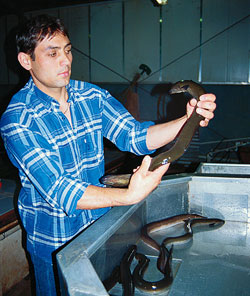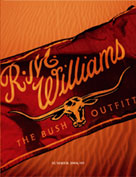NATURAL OUTBACK
 The secret life of eels
The secret life of eels
Nest time you see a mature eel in a dam or river, spare a thought for the journey it embarked upon to the South Pacific – just to reproduce.
Story and photos Martin Auldist
Australian eels suffer from a public relations problem. Their slithery, slippery, snake-like appearance isn’t exactly endearing. In fact, there’s something about them that many people find just plain creepy. But there is much more to eels than first meets the eye. The secret lives of these native fish are an amazing natural phenomenon, the full extent of which is yet to be fully understood.
The remarkable life-cycle of eels is being studied by
Lachlan McKinnon at the Department of Primary Industries’ Marine and Freshwater
Resources Institute
at Queenscliff, Victoria. According to Lachlan – an agricultural science
graduate of La Trobe University – wild adult eels can reach 15 years of age
before they suddenly feel the call to reproduce. They then migrate downstream
and out to sea, where they spawn in water more than 300 metres deep. “Most
Australian eels spawn somewhere in the South Pacific Ocean, near New Caledonia,
we think,” he explains. So adult eels starting life in Victoria travel several
thousand kilometres to spawn and then return to their freshwater home. Meanwhile,
out at sea, the fertilised eggs hatch into larvae that drift on ocean currents,
eventually ending up back on the Continental Shelf. Here, they metamorphose
into the next stage of the lifecycle, called glass eels, which are carried
by tides into rivers and coastal estuaries that have some freshwater outflow.
Once in contact with
freshwater, glass eels – by now about six months old – develop into elvers
or miniature versions of adult eels. They swim upstream, and 15 years later
the cycle begins again.![]()
Full story OUTBACK Issue 37 October/November 2004


